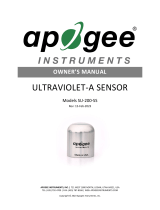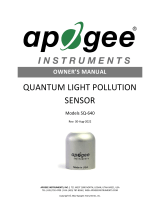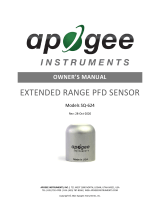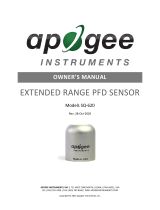INTRODUCTION
Radiation that drives photosynthesis is called photosynthetically active radiation (PAR) and, historically, is defined
as total radiation across a range of 400 to 700 nm. PAR is almost universally quantified as photosynthetic photon
flux density (PPFD) in units of micromoles per square meter per second (µmol m-2 s-1, equal to microEinsteins per
square meter per second) summed from 400 to 700 nm (total number of photons from 400 to 700 nm). However,
ultraviolet and far-red photons outside the defined PAR range of 400-700 nm can also contribute to
photosynthesis and influence plant responses (e.g., flowering).
Data from recent studies indicate that far-red photons synergistically interact with photons in the historically
defined PAR range of 400-700 nm to increase photochemical efficiency in leaves (Hogewoning et al., 2012;
Murakami et al., 2018; Zhen and van Iersel, 2017; Zhen et al., 2019). Measurements from whole plants and plant
canopies indicate adding far-red photons (using far-red LEDs with peaks near 735 nm and outputting photons
across a range of about 700-750 nm) to radiation sources outputting photons in the 400-700 nm range increases
canopy photosynthesis equal to the addition of the same number of photons in the 400-700 nm range for multiple
species, and C3 and C4 photosynthetic pathways, but far-red photons alone are photosynthetically inefficient and
result in minimal photosynthesis (Zhen and Bugbee, 2020a; Zhen and Bugbee, 2020b).
This research suggests that far-red photons drive canopy photosynthesis with similar efficiency as photons in the
traditional PAR range when they are acting synergistically with photons in the 400-700 nm range, meaning when
far-red photons are added to radiation sources outputting 400-700 nm photons. Thus, far-red photons need to be
included in the definition of PAR (Zhen et al., 2021).
Sensors that measure PPFD are often called quantum sensors due to the quantized nature of radiation. A quantum
refers to the minimum quantity of radiation, one photon, involved in physical interactions (e.g., absorption by
photosynthetic pigments). In other words, one photon is a single quantum of radiation. Sensors that function like
traditional quantum sensors but measure a wider range of wavelengths can be thought of as an ‘extended range’
quantum sensor.
Typical applications of traditional quantum sensors include incoming PPFD measurement over plant canopies in
outdoor environments or in greenhouses and growth chambers and reflected or under-canopy (transmitted) PPFD
measurement in the same environments. The extended photosynthetically active radiation (ePAR) sensor detailed
in this manual uses a detector that is sensitive to radiation from 383-757 nm ± 5 nm, which allows it to measure
photons from Far-red.
Apogee Instruments SQ-600 series ePAR sensors consist of a cast acrylic diffuser (filter), photodiode, and signal
processing circuitry mounted in an anodized aluminum housing. A cable to connect the sensor to a measurement
device is also included. SQ-600 series ePAR sensors are designed for continuous photon flux density measurements
in indoor or outdoor environments. SQ-610 models output an analog signal that is directly proportional to photon
flux density. The analog signal from the sensor is directly proportional to radiation incident on a planar surface
(does not have to be horizontal), where the radiation emanates from all angles of a hemisphere.
Hogewoning et al. 2012. Photosynthetic Quantum Yield Dynamics: From Photosystems to Leaves. The Plant Cell,
24: 1921–1935.




























